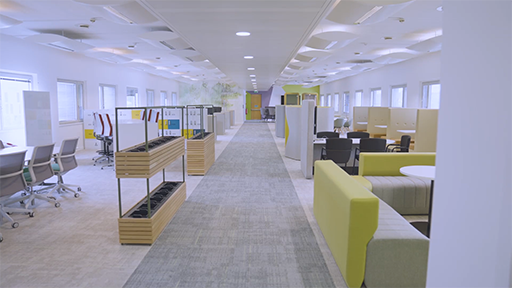5.3 Using space to work differently
As an organisation you have limited power over a ‘remote’ location that you do not have direct responsibility for, and you need to consider ways you can encourage your employees to take responsibility for reducing their carbon footprint.
One approach to understand more about your organisational needs is to run test-and-learn experiments with spaces and engage all your stakeholders in these conversations. The Open University has approached this by designing creative hubs – known as ‘Show homes’ – to explore the different ways of using space and how teams can come together with accessibility and inclusion at the forefront. Dr Nick Barratt, the Director of Learner and Discovery Services at The Open University, explains the approach and insights the OU hopes to gain from this approach.

Transcript
Remote co-working hubs
One of the challenges for hybrid working is that the infrastructure and wellbeing of remote workers can be variable. The Welsh government ran a survey in 2021 to explore the desire for remote working hubs and has set a long-term ambition of 30% of the Welsh workforce to be based away from a traditional office. The aim is to help town centres reduce congestion and cut carbon emissions. (Source: gov.wales [Tip: hold Ctrl and click a link to open it in a new tab. (Hide tip)] ) They now have over 30 remote working hubs throughout Wales. Find your local remote working hub
The result of this has been the release of funding to create remote working hubs. Collaborative working spaces are not a new concept. Most organisations do not own their premises and lease shared offices and spaces, often in large office blocks that house numerous organisations. These shared spaces are likely to become more popular as organisations re-evaluate the space needed for their workforce.
Smaller co-working spaces existed prior to the pandemic, but were predominately used by small business owners or the freelance community. However, they offer those who now work remotely for larger organisations an alternative to working from home or travelling to the office, which may be useful if their domestic situation makes working from home a challenge.
In the video Llinos Neale from Welsh ICE talks about how the use of remote working hubs have evolved since the pandemic.

Transcript
Activity 17: Think about how you can use both onsite and remote space more effectively
Read the following articles, which provide insights into how larger organisations approach reimagining the office.
- Reimagining the office and work life after COVID-19
- Coworking Post-Covid: WeWork’s Predictions for 2022
Consider what you have learned in this section and think about how you can use both your on-site and remote spaces more effectively, and what you can do to make them more sustainable.
Here are few areas you may wish to consider:
- Green spaces
- Catering facilities and provisions – do you ban single-use cups?
- Who is in your supply chain – what is their commitment to sustainability?
- What are the expectations for new builds and retro-fit projects?
- How accessible are buildings?
- What are your travel policies?
- Guidance for remote workers on setting up their home office environment.
- Guidance for remote workers on how they can reduce their carbon footprint within the own location.
- Impact on your local community, both benefits and negative impacts.
